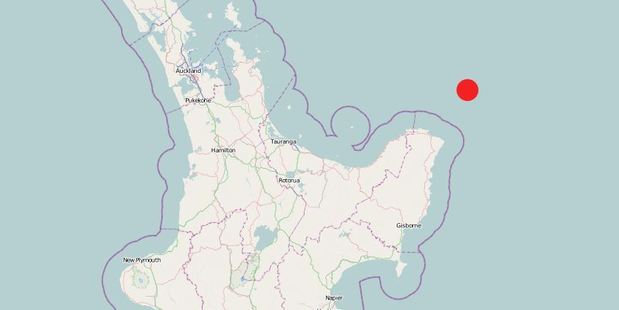
The East Cape has been rocked by a "severe" 5.8 magnitude earthquake this morning.
It struck at 8.41am at a depth of 7km, 75km north-east of Te Araroa.
An earlier report put the quake at magnitude 5.3 and of strong intensity, but this has since been upgraded.
So far there have been no reports of injuries or damages, though hundreds reported feeling the off-shore quake.
The civil defence coordinator for Te Araroa, Hal Hovell, said he was not aware of any problems caused by the earthquake.
"A lot of our people didn't even feel it. It shook a bit and made the house creak."
A police spokeswoman said, "The police have had no calls about the earthquake."
"The plates in the kitchen were starting to clang, the bottles were starting to knock together," she said. "It was almost a repeat of the one we had at the start of September - it was long and slow."
Anderson said the quake went on for about 20 seconds, but finished before she and her staff were able to "stop, drop and hold".
She was "naturally scared", given the last quake, but said the guests didn't appear too concerned.he motel owner said the community had done a lot to prepare for emergencies.
"We are all very aware of how to come together and get to safety."
Whakatane resident Ani Rolleston said the "gentle roll" lasted a few seconds in her part of the country.
"Enough to wake me from a nap after getting up to watch a great game by ABS."
On the GeoNet website 427 people reported feeling the quake from all around the North Island and even the upper South Island.
One Auckland resident, Katherine Heatley, said she had felt all three of the recent larger quakes in the area.
"The first one was really bad as we live on the 28th floor and the building was swaying pretty bad and all the metal blind pull-up systems were violently smashing on the windows," she said.
"Whenever I hear these smashing now I know there is an earth quake! So heard them banging this morning for about 20 secs and knew it was an earthquake..... who needs a Rictor [sic] scale!!!
A "normal" aftershock sequence
GNS duty seismologist Anna Kaiser said the quake was part of the sequence of aftershocks that followed the larger 7.1 quake to hit the region earlier this year.
The East Cape was struck by a powerful 7.1 magnitude earthquake on September 2, which hit about 100km offshore.
It was 22km deep, caused damage to houses, and was felt by tens of thousands of people.
Scientists at the time said they couldn't rule out the possibility of a strong quake greater than magnitude 8 hitting the East Coast in the coming month.
Seismologists predicted three different scenarios for the 30 days following the 7.1 tremor.
The worst case was it triggering a significantly larger quake at the point where the Pacific and Australian plates meet.
"This scenario is very complex and when combined with the current uncertainty in our models, we can't confidently put a probability estimate on it occurring," said GeoNet at the time.
Despite the large "triggered" tremor being "very unlikely", scientists could not discount the possibility of it happening.
Kaiser said the 5.8 quake was the natural continuation of the bigger shake.
"It's located right in the heart of the recent seismic activity in that area," she said. "This goes on for weeks and months after a big earthquake, or even longer."
She said the size and location of the quake meant it was an aftershock of the original 7.1, not a new one of its own.
While it had been classed as a severe earthquake Kaiser said it wasn't the biggest aftershock the area had had since September.
"On the same day as the 7.1 we did see some larger ones, so it's up there," she said. "But it's not the biggest one."
She said the aftershocks were likely to continue in the coming weeks and days - but this was well within the norm of what happened after a larger quake.
"A 5.8 we could see a reinvigoration of aftershocks in the area after this, but typically we would see this anyway," she said. "The most likely scenario is an ongoing aftershock sequence."
So far four aftershocks have been felt following this morning's 5.8 - with two coming in at greater than 3.5 in magnitude.
The largest aftershock, was 4.2, at a depth of 17km, 80km north-east of Te Araroa.
http://www.nzherald.co.nz/nz/news/article.cfm?c_id=1&objectid=11725434
No comments :
Post a Comment